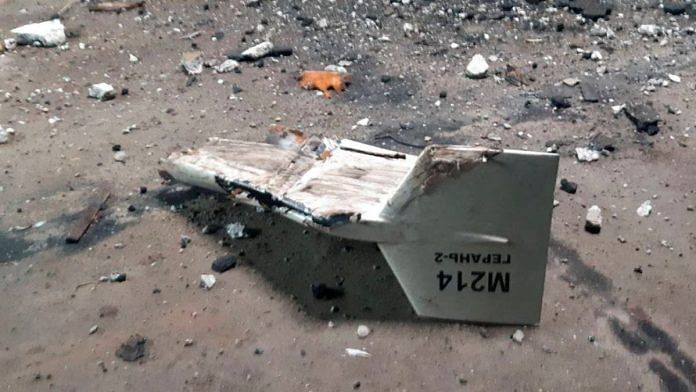New Delhi: On 26 September, Russian forces used an Iranian-made ‘suicide’ drone Shahed-136 to attack a Ukrainian command post in Odesa. Reports suggest that over the past few days, Russia has hit multiple targets using these Iranian-supplied drones—including civilian structures and amenities—leading to the death of several Ukrainians.
Video reportedly of a Iranian Shahed-136 loitering munition over Odesa. https://t.co/LLYyhB8a2I pic.twitter.com/OmrhNe896j
— Rob Lee (@RALee85) September 23, 2022
Reportedly the aftermath of a Shahed-136 loitering munition strike in Odesa. 6/https://t.co/uunhsc9Pgb pic.twitter.com/JTk7xhRE6J
— Rob Lee (@RALee85) September 23, 2022
Sergey Bratchuk, the spokesman of the Odesa regional military administration, confirmed the Russian attacks on his Telegram channel Monday.
“After the previous night’s enemy attack by kamikaze drones of the “Shahed-136″ type, the dark time of the day passed without shelling,” Bratchuk wrote.
Consequently, Ukraine’s President Volodymyr Zelenskyy and his advisors met on Monday to discuss ways to counter Russia’s new weapons of attack, essentially the Shahed-136 drones.
The Ukrainian Air Force in a Twitter post on 25 September, cited they have destroyed six “Shahed-136” drones and one “Mohajer-6” drone over the past few days.
On September 23, anti-aircraft missile units of the Air Force of the Armed Forces of Ukraine destroyed 9 aerial targets.
6⃣ "Shahed-136" drones
1⃣ "Mohajer-6" drone
1⃣ "Mi-8" helicopter
1⃣ "Su-25"Video: destruction of the "Shahed-136" drone pic.twitter.com/MndjPAeBNC
— Ukrainian Air Force (@KpsZSU) September 24, 2022
On Tuesday, the armed forces of Ukraine confirmed that they have gunned down three Iranian drones which attacked the southern Ukrainian city of Mykolayiv.
“About 8 o’clock in the morning, the anti-aircraft defense of the Naval Forces of the Armed Forces of Ukraine destroyed three of the three Shahed-136 kamikaze drones that attacked Mykolayiv region,” Ukraine’s air force wrote on their Telegram account.
Earlier in July, reports surfaced of Iran supplying their Shahed series drones, along with ‘hundreds’ of unmanned aerial vehicles, to Russia for use in its ongoing war in Ukraine. The Islamic nation also supplied Russia with their Mohajer-6 series drones. These drones arrived in Russia at the end of August. With these precision strikes being undertaken, the Shahed drones are now an active part of Russia’s battlefield arsenal.
This is not the first time Iran has supplied its drones to a foreign nation or a sub-state actor. Scholars Michael C. Horowitz, Sarah E. Kreps, and Matthew Fuhrmann, in their journal, ‘Separating Fact from Fiction in the Debate over Drone Proliferation’, for International Security in 2012, noted how Hezbollah possesses an “array of drones acquired from Iran, including the Ababil, a surveillance drone.”
The trio pointed out that Hezbollah used the Iranian-developed Shahed-129 drones to attack al-Nusra forces in Syria in 2014.
ThePrint explains the features of the Iranian Shahed-136 loitering munition, or ‘suicide’ drone.
A modern ‘loitering’ drone
The Shahed-136 is a modern “swarming” loitering drone built to attack ground targets. Swarm drones are a group of unmanned aerial vehicles that operate in coordination. Loitering munitions are slow, propeller-powered missiles. Iran has actively embraced loitering munitions over the past few years to attack oil facilities in Saudi Arabia.
The ‘suicide’ drone has a range of 2,200 kilometres and has been built by the Iran Aircraft Manufacturing Industrial Company (HESA). However, their ability to carry warheads is limited, usually ranging between 5-30kgs.
Justin Bronk, a senior fellow at British think-tank Royal United Services Institute, said, “the Shahed-136 offer a relatively cheap way for states and some non-state groups to mount long-range attacks on fixed targets (using GPS/INS navigation) or radars (using an anti-radiation seeker).”
Today loitering munitions like the Shahed-136 offer a relatively cheap way for states and some non-state groups to mount long range attacks on fixed targets (using GPS/INS navigation) or radars (using an anti-radiation seeker). However, there are significant limitations (8/20) pic.twitter.com/cYqXa2vuig
— Justin Bronk (@Justin_Br0nk) September 26, 2022
Commonly referred to as a ‘suicide’ drone, the aircraft strikes a target by crashing into it along with the explosives on it. However, some refer to it as a hybrid between an unmanned aircraft and a cruise missile.
Limitations
The Shahed-136 drone isn’t without its limitation as it cannot be a quick substitute for Russia’s diminishing aircraft capability in the ongoing conflict.
Bronks explains that Shahed’s navigation and terminal accuracy are based on commercial GPS systems. Both can be thwarted if the GPS is jammed, blocked, or turned off. Further, its ability to only carry a warhead between 5-30 kgs limits its strike capabilities.
Firstly they rely on commercial GPS for navigation and terminal accuracy. If GPS is jammed then both will degrade rapidly. Secondly the warhead capacity is small (typically 5-30kg) which limits damage and viable target sets compared to regular bombs, missiles or artillery. (9/20) pic.twitter.com/qqEK1DVnuY
— Justin Bronk (@Justin_Br0nk) September 26, 2022
‘Slow and low-flying’
The drone also lacks the ability to strike moving targets and has minimal defence mechanisms against anti-UAV systems. Bronks notes they are “slow and low-flying”, which limits their usage as quick, counterstrike weapons on the battlefield.
Though, these problems can be addressed via small adaptations and tweaks like adding — advanced warheads which can enable multiple strike capabilities, turbojets to increase the drone’s speed, and electronic systems to detect radars.
However, all of these fixes will be costly and significantly drive up the cost of the Shahed-136 — which is an essential factor for Russia’s purchase of the drones.
(Edited by Yimkumla Longkumer)



